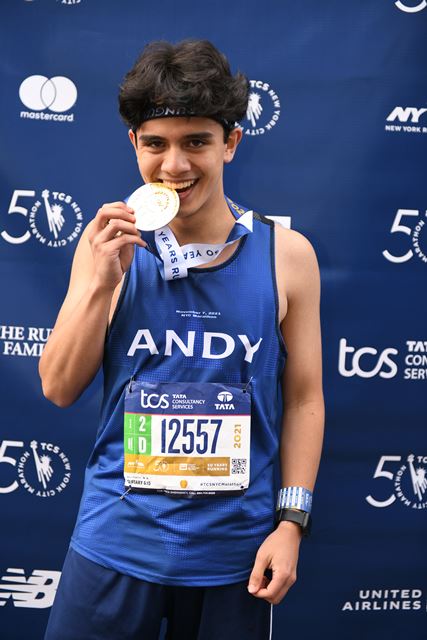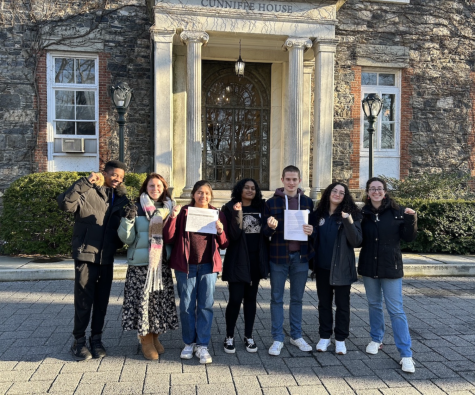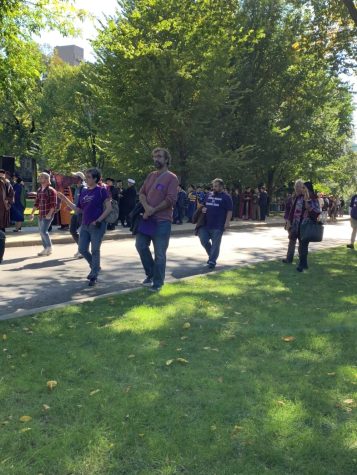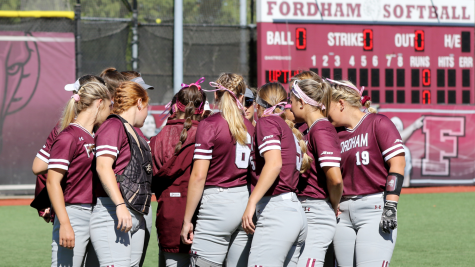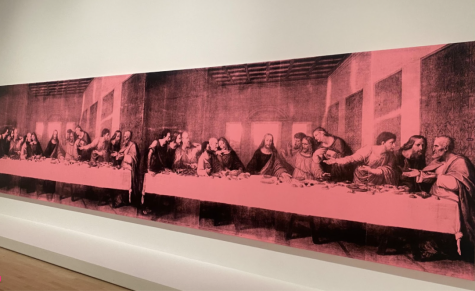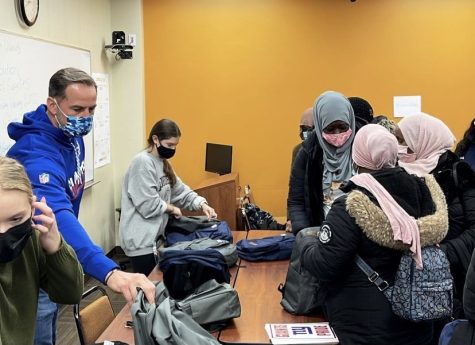Fordham Sophomore Runs NYC Marathon for Charity
When I first met with Andy Rodriguez for our interview for the Ram, I watched him limp out of O’Hare Hall. He held his hands on his legs, helping himself make his way over to our table. His body struggled in recovering from the extreme physical activity he had participated in just days before.
On Nov. 7, Andy Rodriguez, FCRH ’24, completed the TCS New York City Marathon, running a full 26-mile race across the city’s five boroughs.
“Just to be able to say you did a marathon sounds amazing, and I had actually thought about it since last year. Doing the New York City Marathon someday,” Rodriguez said.
However, in order to actually register, Rodriguez needed to partner with and fundraise for a charity. The marathon required him to pick a charity partnered with the event.
After spending time researching each one, Rodriguez decided to raise $2,500 in support of the EJ Autism Foundation.
The stakes of this fundraising project were high. If Rodriguez could not raise the money by Nov. 7, he would not be allowed to participate in the marathon. “What [the EJ Autism Foundation] were raising money for this year — they wanted to purchase a vacation home for their patients with autism,” Rodriguez said. “But they also use the money for resources they might need to treat and help their patients.”
Rodriguez publicly announced his fundraising efforts on Aug. 31, giving him a little over nine weeks to raise all $2,500. “At first, I wasn’t sure how easy it would be to reach $2,500,” Rodriguez said. After the first few weeks, he was able to reach about half of his goal. “I realized I didn’t have to worry about it as much,” said Rodriguez. Fundraising steadily rose throughout September and October before he reached his goal just a week before the marathon. Cutting it close, Rodriguez managed to raise $2,600 by the day of the marathon, a little over the original goal.
Simultaneously, Rodriguez spent the same time physically preparing for the marathon. Prior to the last week of August, Rodriguez had very little experience in running marathon distances. “I did track in high school, but my events were half a mile,” Rodriguez said. “Up through June of this year, the most I had run was three miles.”
Rodriguez registered for the marathon in mid-August but used the first two weeks to pre-train; he changed his diet and prepared himself to start getting into the circuit of regular physical training. By the time he completed his pre-training, he was left with eight weeks to get his body in shape for a 26-mile run.
“If you look online, people recommend 12 to 16 weeks. I had two months. The odds were against me from the start,” Rodriguez said, describing the pressure of training in a small time frame. “I was looking for a training plan that fit the eight weeks I had, but a lot of the articles I found said that ‘if you’re starting to train with only eight weeks left to go, don’t run it and find another event.’”
In order to make up for lost time, Rodriguez turned to a rigorous workout schedule, balancing his training regimen with his classes, job, clubs and social life. “I had to run five times a week. I would rest on Mondays and Fridays. The other days I’d have to go on a run,” Rodriguez said. “I had a training plan, so I knew that I had to run each day, but I didn’t know what time of day I’d be able to do it. So, whenever I found the time I’d go and run … Each week it gets harder, and the hardest weeks were the same weeks as midterms. I would have to do my midterms and then find time to run 16 miles, which takes two hours — which is insane.”
Knowing that he would have to be in the best shape possible in order to make the marathon, Rodriguez said he stayed consistent on his schedule. “Sometimes I’d just wake up really early and, towards the last month, I was too exhausted to wake up early so I’d go at night, at 8 or 9 p.m.,” said Rodriguez. “I’d just take a break from doing homework or whatever, go on a run, and go back and keep working.”
In early October, at the mid-point of his training, Rodriguez signed up for a half-marathon in Bay Ridge, Brooklyn, to get an idea of how well he was progressing. Rodriguez had been impressed with his training up until that point. “I was aiming for an hour and fifty minutes or something,” he said. “I ended up doing an hour and a half. After that, I was pretty confident. I’m going way faster than I should be.”
Unfortunately, when the marathon was only two weeks away, a wrench got thrown into the gears of Rodriguez’s training: a leg injury. “My legs were hurting just walking,” Rodriguez said, “I thought I had shin splints, maybe an ankle fracture. I couldn’t really go get it checked out because there was a risk I’d go and they’d say, ‘You can’t run the marathon.’”
With very few options left, Rodriguez’s risky solution was to take a week off of training despite only having two left before marathon day. Rodriguez said that week-long break made him afraid of setbacks in his training and that the injury would not be recovered by Nov. 7, the day of the big race. Still, he was determined. “I had to keep going,” Rodriguez said.
When Nov. 7 rolled around, Rodriguez started the day of the marathon early. Waking up at 4 a.m., he had to catch the Staten Island Ferry to make it to the marathon’s origin point in time for registration. “I started quite late, actually at 9:50 a.m. But I had to be there earlier to check-in, show my vaccine, all that good stuff,” he explained.
For about the first half of the marathon, Rodriguez was making smooth progress. However, once he reached mile 16, entering Manhattan from Queens, he began to feel his right leg cramp up. “I ran through it,” he said. “I’ve done that before. It went away and then my left leg started. I ran through that — it went away and then both of them hit me at the same time. I had to walk a bit, stretch it out and it just kept going like that for the next 10 miles,” Rodriguez explained.
He managed to run through the pain for a good distance before it became too much to handle. “At mile 22, I fell because my legs just locked up,” said Rodriguez. “I laid down for a bit. I tried to get up and walk and I couldn’t walk. I took one step and I was back on the ground. I had to take five minutes and keep stretching, and then I had to push the last four miles, push myself to jog and run through all the pain.”
In order to keep going through with the race, Rodriguez thought about one of his primary motivators: his friends and family that cheered him on from the sidelines. “If they weren’t there supporting me, I probably would’ve maybe not finished the race. It’s only because I knew they were there watching that I had to keep going,” he said. “All my friends were waiting for me at Columbus Circle, so I was like, ‘They’re waiting for me at Columbus Circle, I have to make it there.’ So I did. I pushed myself, and that’s probably why I can’t walk now because I ran ten miles with cramps.”
In the days after, Rodriguez’s body was a physical disaster. “It was terrible,” Rodriguez recalled. “I couldn’t walk to the bathroom in my dorm. I remember I got out of bed and I was like, I need to go to the bathroom and I almost fell down. I had to be constantly grabbing onto something like a chair, bed, the wall — my roommate.” Rodriguez said he even had to miss class and take time off work while in recovery.
Rodriguez said he is considering a second NYC marathon in order to reach his goal of four hours, a goal he only missed last week by four minutes. Overall, Rodriguez said it was all worth it, even the pain of recovery. “It was a great experience,” he said. “It was great to have something to constantly work towards. Now that it’s done, I feel confused. What am I supposed to do?”
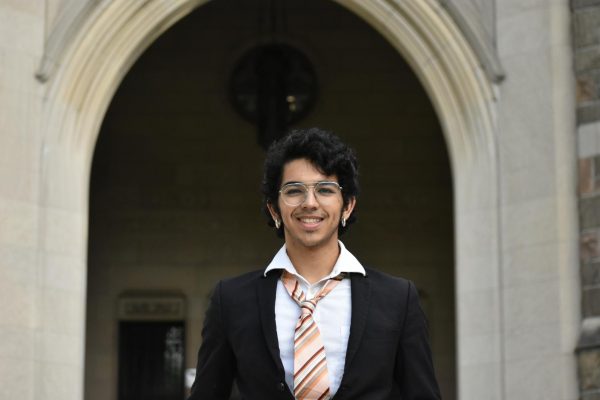
Sebastian Diaz is a senior from Chapel Hill, N. C. who is double majoring in journalism and film. After starting as a news reporter for The Fordham Ram...



































































































































































































